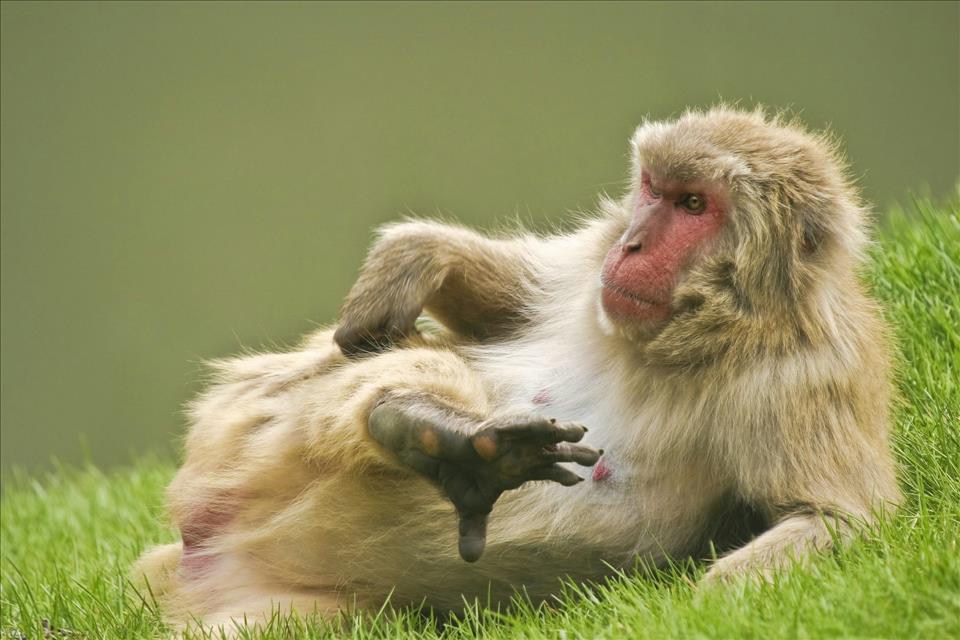
How Scratching Monkeys Can Help Us Understand Emotions And Consciousness
Self-scratching among non-human primates is known to indicate social tension and anxiety. The two researchers from Kyoto University, Japan, wanted to use this link to work out whether being anxious (and so scratching a lot) made their monkey subjects more pessimistic, or whether their pessimism was what drove their anxiety (and their scratching).
Their findings suggest the former is true, as the primates were more likely to make a pessimistic choice if they had scratched their body. This not only provides evidence for an important theory about how physiological changes are linked to emotional states, but also shows that monkeys' body language can reveal some interesting cues about how animal consciousness may differ from that of humans.
Several studies have previously shown that self-scratching in primates is linked to social tension and emotional state. For instance, a 1991 study found monkeys who were given an anxiety relief drug seemed to scratch themselves less, whereas monkeys who received an anxiety-inducing drug increased self-scratching.
Research has also shown subordinate capuchin monkeys self-scratch more when they are approached by a dominant individual, perhaps due to the increased risk of aggression. Japanese macaques with a high tendency to scratch themselves are less likely to make peace after a conflict with their group companions.
Researchers of animal and human behaviour often use self-scratching as a measure of short-term changes in anxiety, social tension and emotional state. Self-scratching is also linked to social tension in humans : people often scratch more during a short period of high anxiety.
Self-scratching is an example of what behavioural scientists call displacement behaviour , which includes yawning, lip-biting, fumbling and face-touching.
Research has shown it can also allow us to better cope with anxiety. For example in 2012, UK researchers asked participants to do difficult (and in some cases unsolvable) arithmetic calculations in front of an audience, and found that participants who displayed higher rates of self-scratching during the test also reported a lower level of anxiety after the test.
Japanese macaques are well known for bathing in hot springs. mapman/Shutterstock
The researchers at Kyoto University found that macaques seem to have a different relationship to displacement behaviour than humans.
Iki and Adachi worked with six adult Japanese macaques (Macaca fuscata). They used videos of a macaque scratching themselves to induce self-scratching in their study subjects, since this behaviour is contagious, similar to yawning .
They trained the monkeys to choose between different options on a greyscale touchscreen. The darker the shade of grey, the more likely the monkeys were to get a food reward.
When they chose the lightest shade of grey, the touchscreen temporarily blanked out. The darkest shade of grey always rewarded the monkeys with food and the three shades in the middle had inconsistent outcomes.
These stimuli tested whether the monkeys were biased towards optimism or pessimism. The monkeys who self-scratched were more likely to be pessimistic about the outcome of the inconsistent stimuli. The researchers measured pessimism in terms of reaction time.
The longer it took a monkey to choose the ambiguous shades, the more pessimistic the researchers believed the monkeys to be. Monkeys didn't seem to hesitate if they didn't scratch. The researchers argue that scratching was a sign the monkeys were anxious and being anxious made the monkeys more pessimistic about the future.
Their study was one of the first to test what's known as the James-Lange theory in non-human animals. The theory argues there is a sequential connection between behavioural and physiological components of emotions and our experience of these emotions. According to this idea, behavioural and physiological responses happen first. This means, for example, that having an irregular heartbeat would make us anxious.
The new results support the James–Lange theory. Negative emotions (measured by self-scratching) induce pessimism, and not vice-versa. The areas of the brain linked to basic emotions, such as fear, are similar in mammals . However, it is unclear whether the way we experience these emotions is comparable to other species.
For example, two human subjects who have similar physiological responses in relation to anxiety may perceive it differently. One subject may be OK with anxiety, another subject may struggle to handle such situation. We know non-human primates have individual responses to anxiety, but we don't fully know why and we can't ask them.
This study highlights interesting similarities, but also differences between humans and other species. A possible difference is related to consciousness. Humans have a conscious experience of their bodily responses which affects how we respond to them.
An irregular heartbeat can make us anxious. This isn't just because it causes a physiological response that induces stress, but also since we know that something is wrong when we feel that our heartbeat is irregular, which can make us even more anxious.
I say this is“possibly” a difference because some researchers argue that other animals, like chimpanzees or elephants, may have some form of consciousness.
Humans, unlike the Japanese macaques of this study, can also have the opposite temporal pattern predicted by the James-Lange theory. If I know that I have an exam tomorrow, this thought may make my heartbeat become irregular.
The short-term link between emotional responses and the perception of these responses could be shared by many primates (the group of animals that include humans, other apes, monkeys and lemurs) and other mammals too. But research is yet to demonstrate this conclusively.
Research like the one by Iki and Adachi demonstrates the importance of studying a wide range of species, and not just the ones closest to humans, such as chimpanzees and bonobos, to better understand what factors shape behavioural and cognitive skills in the animal kingdom.

Legal Disclaimer:
MENAFN provides the information “as is” without warranty of any kind. We do not accept any responsibility or liability for the accuracy, content, images, videos, licenses, completeness, legality, or reliability of the information contained in this article. If you have any complaints or copyright issues related to this article, kindly contact the provider above.






















Comments
No comment